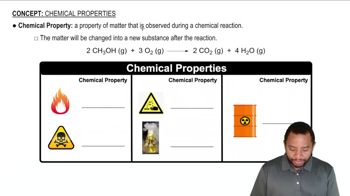Ch.22 - Chemistry of the Nonmetals
Chapter 22, Problem 63
Complete the exercises below. Give the chemical formula for: a. hydrocyanic acid, b. nickel tetracarbonyl, c. barium bicarbonate, d. calcium acetylide, e. potassium carbonate.
 Verified step by step guidance
Verified step by step guidance1
Identify the chemical formula for hydrocyanic acid: Hydrocyanic acid is composed of hydrogen and the cyanide ion. The chemical formula for the cyanide ion is CN^-. Therefore, the formula for hydrocyanic acid is HCN.
Determine the chemical formula for nickel tetracarbonyl: Nickel tetracarbonyl is a coordination compound consisting of a nickel atom surrounded by four carbon monoxide ligands. The chemical formula is Ni(CO)_4.
Find the chemical formula for barium bicarbonate: Barium bicarbonate is composed of barium ions and bicarbonate ions. The chemical formula for the bicarbonate ion is HCO_3^-. Since barium has a charge of 2+, the formula is Ba(HCO_3)_2.
Identify the chemical formula for calcium acetylide: Calcium acetylide is composed of calcium ions and acetylide ions. The acetylide ion is C_2^2-. Since calcium has a charge of 2+, the formula is CaC_2.
Determine the chemical formula for potassium carbonate: Potassium carbonate is composed of potassium ions and carbonate ions. The chemical formula for the carbonate ion is CO_3^2-. Since potassium has a charge of 1+, the formula is K_2CO_3.
Key Concepts
Here are the essential concepts you must grasp in order to answer the question correctly.
Chemical Nomenclature
Chemical nomenclature is the system of naming chemical compounds based on their composition and structure. It follows specific rules set by organizations like IUPAC, which help in identifying the type of elements involved and their arrangement. Understanding nomenclature is essential for translating names into chemical formulas and vice versa.
Recommended video:
Guided course

Chemical Properties
Polyatomic Ions
Polyatomic ions are charged entities composed of two or more atoms covalently bonded together, which function as a single ion. Common examples include bicarbonate (HCO3-) and carbonate (CO3^2-). Recognizing these ions is crucial for writing correct chemical formulas, especially for compounds that contain them.
Recommended video:
Guided course

Polyatomic Ion Variations
Valency and Oxidation States
Valency refers to the combining capacity of an element, often determined by the number of electrons it can lose, gain, or share to form chemical bonds. Oxidation states indicate the degree of oxidation of an atom in a compound. Understanding these concepts is vital for determining the correct ratios of elements in chemical formulas, ensuring that the overall charge is balanced.
Recommended video:
Guided course

Oxidation Numbers
Related Practice
